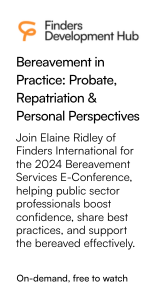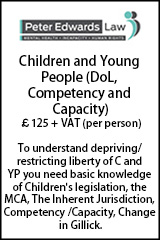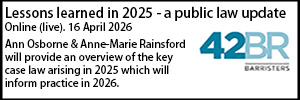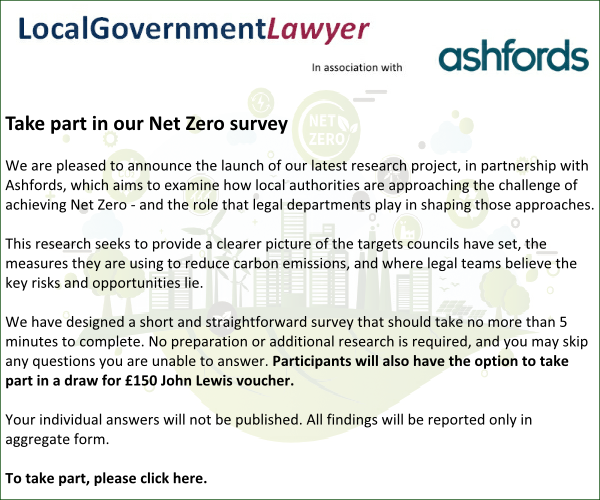Court of Protection case update: May 2025
- Details
Sarah Hutchinson rounds up the latest Court of Protection rulings of interest to practitioners.
Calderdale Metropolitan Borough Council v LS & Anor [2025] EWCOP 10 (T3) (13 March 2025)
This case concerned the determination of capacity of a 31-year-old woman (LS), who asked to be referred to a ‘Stitch’ throughout the judgment. Stitch has a diagnosis of mild intellectual disability, with a full-scale IQ of 52. She has Attention Deficit Hyperactivity Disorder and a dysfunctional attachment style. Stich is reported to have microscopic brain disorder, associated with microcephaly at birth. She also experiences difficulty in processing and assimilating information, exacerbated by a cognitive rigidity. Stitch’s need to be liked rendered her vulnerable to coercion. A summary of Stitch’s background history is at paragraphs 13 to 21.
Stitch was first subject to proceedings under the Mental Capacity Act 2005 (MCA2005) in 2019 where a number of interim and final substantive decisions were made about Stich. The issue of Stitch’s decision-making capacity was a live issue throughout these proceedings which were described as ‘lengthy and complex’. A final order in these proceedings was made on 12 June 2023 with the conclusion that Stich had decision making capacity in in most areas of her life. Extracts from the ex tempore judgment on 12 June 2023 in relation to capacity decisions are provided at paragraphs 22 to 23.
Concerns relating to Stitch’s capacity in a number of areas almost immediately after the order had been made and further assessments of capacity were undertaken. A fresh application for best interest declarations and orders was issued in May 2024. This was following Stitch acquiring higher degrees of autonomy that she had previously enjoyed in her placement. It was evidenced that Stitch found this to be overwhelming and subsequently her behaviour and presentation changed significantly. Details relating to the re-assessment of Stitch and the safeguarding incidents which resulted in the application are summarised at paragraphs 24 to 34. Of significance, during the re-assessment the view of the assessor was that throughout the first set of proceedings, Stitch had become adept at retaining limited information which enabled her to repeat words and phrases that gave assessors the impression that she was more capable than she actually was. Additionally, it was submitted that Stich is vulnerable to exploitation and coercion.
There was no dispute that Stitch lacked capacity to conduct litigation. The other domains in issue were:
- residence;
- care;
- contact with others;
- contact: other specific relationships;
- use of the internet and social media;
- engaging in sexual relations.
Legal framework
The court acknowledged that the starting point at section 1(2) of the MCA 2005 is that there is a presumption of capacity. This was highlighted by Lord Stephens in A Local Authority v JB (Rev1) [2021] UKSC 52 where he noted: “all dealings with persons who have an impairment of, or a disturbance in the functioning of, the mind or brain to be based on the premise that every individual is competent until the contrary is proved. The burden of proof lies on the party asserting that a person does not have capacity.”
It was further noted in this case that “… an important purpose of the MCA is to promote autonomy. That purpose aids the interpretation of sections 2 and 3 of the MCA. If P has capacity to make a decision then he or she has the right to make an unwise decision and to suffer the consequences if and when things go wrong. In this way P can learn from mistakes and thus attain a greater degree of independence” and that “A person is not to be treated as unable to make a decision merely because he makes an unwise decision.”
For the purposes of the MCA 2005, “a person lacks capacity in relation to a matter if at the material time he is unable to make a decision for himself in relation to the matter because of an impairment of, or a disturbance in the functioning of, the mind or brain.”
In relation to the ‘material time’ it was highlighted in Z & Ors,Re [2016] EWCOP 4, that “As the wording of the statute makes clear, the point in time at which… capacity is to be tested is now (i.e. “at the material time”).”
The court noted that as detailed in Sheffield City Council v E Sheffield City Council v E [2004] EWHC 2808the bar for assessing capacity must not be set too high.
It was acknowledged that part of the function of the Court of Protection is to promote and protect the autonomy of those who are the subjects of proceedings however, as was noted by Hayden J in Warrington BC v Y (By her litigation friend the Official Solicitor), AB and CD [2023] EWCOP 27:
“The danger of elevating the instinctive need to protect a vulnerable adult to such a degree that it corrupts the integrity of an objective assessment of capacity, is an ever-present danger in this sphere of work and requires vigorously to be guarded against. Paternalism has no place; protection of individual autonomy is the magnetic north of this court.”
As fluctuating capacity was raised as an issue in the case, the court gave consideration to what Lord Stephens said in A Local Authority v JB (Rev1) [2021] UKSC 52:
“Capacity may fluctuate over time, so that a person may have capacity at one time but not at another. The “material time” within section 2(1) is decision-specific (…). The question is whether P has capacity to make a specific decision at the time when it needs to be made. Ordinarily, as in this case, this will involve a general forward-looking assessment made at the date of the hearing. However, if there is evidence of fluctuating capacity then that will be an appropriate qualification to the assessment”. (Emphasis by underlining added).
As there was concern raised that the assessment of Stich in the summer of 2023 may have been overly influenced by the placement’s own view of her welfare, the court gave consideration to Heart of England NHS Foundation Trust v JB [2014] EWHC 342 (COP) where it was cautioned against allowing “the tail of welfare” to wag “the dog of capacity”.
Judgment
The court was careful to guard against reaching a false conclusion on capacity driven by the view of what might be considered as good decision making by Stich and / or bad or unwise decision making.
The court reviewed the assessment evidence from the senior social worker and from the joint expert and was critical of both. The judge noted that the capacity assessment conducted of Stitch in August 2023 was ‘unorthodox’ and lacking in the rigour that is customary and necessary in the Court of Protection. Namely that the assessor failed to clearly set out the purpose of the questions for Stitch and did not specifically advise Stitch that her capacity in several areas was being assessed.
The court considered that the expert report lacked the forensic acuity which was called for in the case. Specifically, it was noted that there was an expectation that there would have been greater discussion in the analysis section of the report in relation to available evidence and triangulating her views with the social worker assessments. The court felt that the failure to do so had led to a one-dimensional report.
The court concluded that Stitch lacked capacity to:
- conduct proceedings;
- make decisions as to:
- where she should reside;
- the care she should receive;
- her contact with others;
- the internet and social media;
- engaging in sexual relations.
Furthermore, the court ordered that sex education and counselling should be provided to Stich in order to support her to regain capacity in relation to her engagement in sexual relations.
There was also an order to file an amended support plan with input from Stitch with the aim of moderating the risks identified in applying the longitudinal view of capacity in relation to residence, care, and contact with her mother.
It was noted that the evidence presented in the application suggests that, at times, Stitch is close to capacity (or even at time capacitous) in her decision making and thought must routinely be given to whether she may gain capacity.
W v P [2025] EWCOP 11 (T3) (13 March 2025)
The case concerned ‘P’, a figure of significant wealth who used to be in the public eye. P has severe dementia; he is unable to communicate at all and his life expectancy is limited. He lacks capacity to make decisions in relation to managing his affairs. P’s wife ‘W’ made an application for authorisation to make a statutory will and enter into a number of lifetime dispositions on behalf of P.
Prior to the hearing, W made an application to the court not to make the standard order pursuant to Practice Direction 4C that the hearing should take place in public. It was her case that there were good reasons not to make such an order and these should be heard in private and without notice to the media.
Legal framework
There is a general rule under COPR 4.1 that Court of Protection hearings are to be heard in private unless the court makes an order under COPR 4.1(3) permitting other persons to attend.
COPR 4.3(3) allows for the court to make an order departing from the general rule, whereby it can order that a hearing can be held in public with restrictions on publication of information about the proceedings as specified by the court.
Practice Direction 4C has been made pursuant to COPR 4.3(3) and the normal practice is for the court to make a transparency order of its own motion for the hearing to be a public hearing but with reporting restrictions to prevent the identification of P. The court referred to the case of Hinduja v Hinduja & Ors [2022] EWCA Civ 1492 [27] [2022] EWCA Civ 1492 [27] and there being a ‘supposition’ that this is appropriate to strike the balance between satisfying the public interest in scrutiny and accountability of the Court of Protection whilst also sufficiently protecting P’s right to privacy.
The court acknowledged that there may be features of a case which may enhance the public interest in transparency but noted that there is “a clear distinction between the public interest and what the public is interested in.” Reference was made to Re the Will of His Late Royal Highness The Prince Philip, Duke of Edinburgh [2021] EWHC 77 (Fam)[59]2021] EWHC 77 (Fam)[59] where it was held by Sir Andrew Mcfarlane that “whilst there may be public curiosity as to the private arrangements that a member of the Royal Family may choose to make in their will, there is no true public interest in the public knowing this wholly private information.”
Whilst this was in relation to the Royal estate, the same principle applies to everyone where there may be an element of public curiosity as referred to in XW v XHXW v XH [2019] EWCA Civ 549.
Judgment
Consideration was given to the requirement for public scrutiny and accountability of court processes and that there is a public interest which lies in knowing what goes on in the court.
The court also considered that in this case a public hearing would result in significant publicity which would serve only to satisfy public curiosity that would amount to a serious intrusion in the private life of P.
Mr Justice Rajah went on to note, “The ‘supposition’ that a transparency order would protect P’s privacy is, in this case displaced. I am satisfied that it is not possible to craft reporting or other restrictions which would protect P’s identity and the privacy of P and his family.”
“There is a very significant risk of jigsaw identification unless the reporting restrictions (and other measures such as exclusion of the public from parts of the hearing) were so stringent as to make a public hearing meaningless. This substantially outweighs any legitimate public interest in this hearing being in public, even with reporting restrictions, and amounts to a good reason for the matter to be heard in private.”
The court concluded that there could be no effective reporting restrictions that would protect P’s identity and that there was no legitimate public interest in the case that would outweigh P’s Article 8 rights to privacy.
The hearing was heard in private, and no notice was given to the press of it.
The court further determined that there would be no published judgment on the substantive application as it “would have to be so heavily redacted it would make little sense.”
Full Judgment: W v P [2025] EWCOP 11 (T3) (13 March 2025)
Sarah Hutchinson is a pupil barrister at Spire Barristers.














































